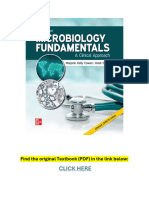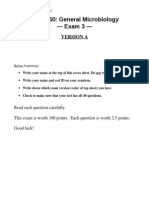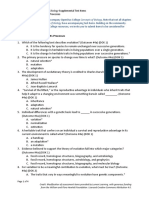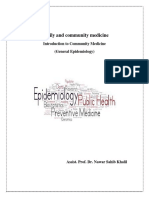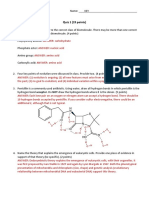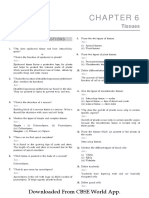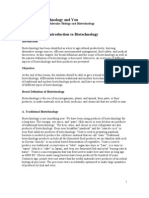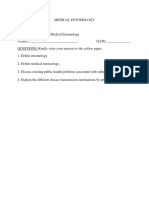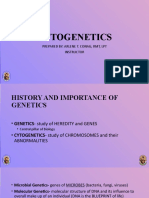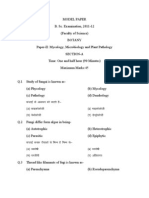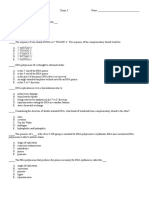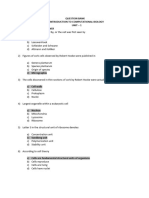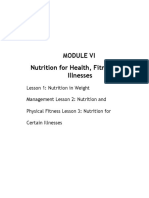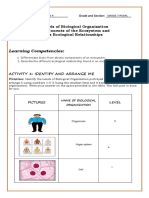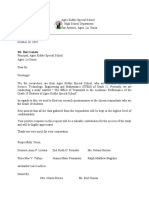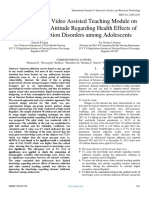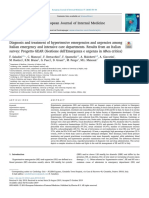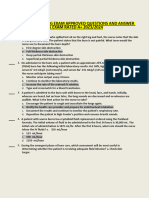0 ratings0% found this document useful (0 votes)
100 viewsIntroduction To Medical Microbiology Exam #1 Study Guide
Introduction To Medical Microbiology Exam #1 Study Guide
Uploaded by
Bangtan J-hopiaThis document provides a study guide for an exam on medical microbiology. It outlines the main topics to be covered, including historical figures in microbiology, branches of microbiology, bacterial morphology, and tools used in microbiology laboratories. Specific topics within bacteria and archaea include flagellar arrangements, cell structures, sporulation, cell walls, habitats, and diseases caused. Eukaryotic microbes such as algae, protozoa and fungi are also addressed. Viral replication, characteristics, capsids and diseases are discussed. The student is advised to study both the guide and lecture notes to be fully prepared.
Copyright:
© All Rights Reserved
Available Formats
Download as DOCX, PDF, TXT or read online from Scribd
Introduction To Medical Microbiology Exam #1 Study Guide
Introduction To Medical Microbiology Exam #1 Study Guide
Uploaded by
Bangtan J-hopia0 ratings0% found this document useful (0 votes)
100 views1 pageThis document provides a study guide for an exam on medical microbiology. It outlines the main topics to be covered, including historical figures in microbiology, branches of microbiology, bacterial morphology, and tools used in microbiology laboratories. Specific topics within bacteria and archaea include flagellar arrangements, cell structures, sporulation, cell walls, habitats, and diseases caused. Eukaryotic microbes such as algae, protozoa and fungi are also addressed. Viral replication, characteristics, capsids and diseases are discussed. The student is advised to study both the guide and lecture notes to be fully prepared.
Original Title
Exam1StudyGuide
Copyright
© © All Rights Reserved
Available Formats
DOCX, PDF, TXT or read online from Scribd
Share this document
Did you find this document useful?
Is this content inappropriate?
This document provides a study guide for an exam on medical microbiology. It outlines the main topics to be covered, including historical figures in microbiology, branches of microbiology, bacterial morphology, and tools used in microbiology laboratories. Specific topics within bacteria and archaea include flagellar arrangements, cell structures, sporulation, cell walls, habitats, and diseases caused. Eukaryotic microbes such as algae, protozoa and fungi are also addressed. Viral replication, characteristics, capsids and diseases are discussed. The student is advised to study both the guide and lecture notes to be fully prepared.
Copyright:
© All Rights Reserved
Available Formats
Download as DOCX, PDF, TXT or read online from Scribd
Download as docx, pdf, or txt
0 ratings0% found this document useful (0 votes)
100 views1 pageIntroduction To Medical Microbiology Exam #1 Study Guide
Introduction To Medical Microbiology Exam #1 Study Guide
Uploaded by
Bangtan J-hopiaThis document provides a study guide for an exam on medical microbiology. It outlines the main topics to be covered, including historical figures in microbiology, branches of microbiology, bacterial morphology, and tools used in microbiology laboratories. Specific topics within bacteria and archaea include flagellar arrangements, cell structures, sporulation, cell walls, habitats, and diseases caused. Eukaryotic microbes such as algae, protozoa and fungi are also addressed. Viral replication, characteristics, capsids and diseases are discussed. The student is advised to study both the guide and lecture notes to be fully prepared.
Copyright:
© All Rights Reserved
Available Formats
Download as DOCX, PDF, TXT or read online from Scribd
Download as docx, pdf, or txt
You are on page 1of 1
Introduction to Medical Microbiology
Exam #1 Study Guide
Main Themes of Microbiology
1. Be able to identify the people of historical significance listed in class and what each one’s
contribution to microbiology was.
2. Be able to identify the different branches of microbiology. (i.e. epidemiology, immunology,
virology, etc…)
3. Know the basic bacterial shapes.
4. Be able to define viroids and prions.
Tools of the Laboratory
1. Know the basic characteristics of the different types of microscopes and any special uses of each.
2. Know the functions of differential, enriched, selective, and general-purpose media.
3. Know how media is classified based on physical form, chemical content, and function.
Bacteria & Archaea
1. Be able to identify and describe the 4 types of flagella arrangements.
2. Know the components of the prokaryotic flagella.
3. Be able to describe a run and tumble and what type of flagella movement causes each.
4. Know the difference between positive and negative chemotaxis.
5. Be able to describe the structure and functions of fimbriae, pilus, glycocalyx, cell wall, cell
membrane, nucleoid/chromatin body, plasmid, cytoplasm, and inclusion bodies.
6. Know the process of sporulation and which bacteria are capable of producing spores.
7. Know the main structural characteristics of the Gram (+) and Gram (-) cell walls.
8. Be able to recognize the different types of prokaryotes based on their descriptions.
9. Know the different habitats (soil, water, specific body parts/systems, etc.) of the different
bacterial species.
10. Know the practical functions (if given; i.e. nitrogen-fixation, antibiotic production,
bioremediation, etc.) of the prokaryotes discussed in lecture.
11. Be able to match the bacterial species with the disease(s) it can cause.
Eukaryotic Cells and Microorganisms
1. Know the characteristics used to classify algae, protozoa, and fungi.
2. Be able to match the eukaryotic organism with the disease(s) it causes.
3. Be able to match the insect vector with the disease(s) it can carry.
An Introduction to Viruses
1. Be able to match the virus with the disease it causes.
2. Know the steps of bacteriophage and animal virus replication and be able to describe what
happens during each step.
3. Know the overall characteristics of a virus.
4. Be able to distinguish the different types of capsomere arrangements.
5. Know the characteristics/functions of the capsid, envelope, spikes, nucleic acid, and inclusion
bodies.
6. Know how viral infections are detected and treated.
This study guide covers the majority of information on the exam but not all of it. You are still
responsible for any information that was covered in the notes but not put on this guide (intentionally
or unintentionally). Good Luck and Study Hard!!
You might also like
- Microbiology Fundamentals A Clinical Approach 4th Edition TextbookDocument28 pagesMicrobiology Fundamentals A Clinical Approach 4th Edition TextbookcepafomeNo ratings yet
- UA Cell Biology Exam 1Document6 pagesUA Cell Biology Exam 1Lucas ThomasNo ratings yet
- MC Chapter 21 TestDocument9 pagesMC Chapter 21 Testmjordan2012No ratings yet
- Basic Allied Health Statistics and AnalysisDocument289 pagesBasic Allied Health Statistics and AnalysisAlaa Abu AishehNo ratings yet
- Rat Dissection Protocol - Intro BiologyDocument10 pagesRat Dissection Protocol - Intro BiologyValar Mathei Padmanadhan100% (1)
- SDSU BIO 350 Exam3 2010 VerA (With Answers)Document5 pagesSDSU BIO 350 Exam3 2010 VerA (With Answers)Ernie RoweNo ratings yet
- Exam3 BIOL1720 Fall2015Document5 pagesExam3 BIOL1720 Fall2015NhiNo ratings yet
- SPAN CSP Volume 2Document176 pagesSPAN CSP Volume 2samer alrawashdeh50% (2)
- Chapter 17: The Immune System and DiseaseDocument1 pageChapter 17: The Immune System and DiseaseFatima BjaijihNo ratings yet
- Chapter 11: Evolution and Its ProcessesDocument4 pagesChapter 11: Evolution and Its ProcessesFatima BjaijihNo ratings yet
- Chapter 19: Population and Community EcologyDocument4 pagesChapter 19: Population and Community EcologyFatima BjaijihNo ratings yet
- Chapter 18: Animal Reproduction and DevelopmentDocument1 pageChapter 18: Animal Reproduction and DevelopmentFatima BjaijihNo ratings yet
- Openstax College Concepts of Biology Supplemental Test Items Chapter 09: Molecular BiologyDocument4 pagesOpenstax College Concepts of Biology Supplemental Test Items Chapter 09: Molecular BiologyFatima BjaijihNo ratings yet
- BBS - Finals Compilation - Project Coffee PDFDocument318 pagesBBS - Finals Compilation - Project Coffee PDFNoel JoaquinNo ratings yet
- Epidem. Lecture 1 & 2Document18 pagesEpidem. Lecture 1 & 2sajad abasew100% (1)
- Quiz 1 (15 Points)Document1 pageQuiz 1 (15 Points)TaiNo ratings yet
- Microbiology Haqs 3rd EdDocument28 pagesMicrobiology Haqs 3rd Edshivaramganji32No ratings yet
- 2021 Chapter 6 Tissue Most IMP QuestionsDocument11 pages2021 Chapter 6 Tissue Most IMP QuestionsGauravNo ratings yet
- PATHOLOGY HAQs 2nd EdDocument26 pagesPATHOLOGY HAQs 2nd Edcharusharma9831240259No ratings yet
- Fundamentals of Microbiology 1Document201 pagesFundamentals of Microbiology 1SHIVANI ITOKARNo ratings yet
- MICROBIOLOGY Exam 2020Document8 pagesMICROBIOLOGY Exam 2020christinejoanNo ratings yet
- Question Text Question Type PointsDocument25 pagesQuestion Text Question Type PointsMagda Tvildiani100% (1)
- Introduction To BiotechnologyDocument5 pagesIntroduction To BiotechnologyGhi GustiloNo ratings yet
- Bacteria (Unit I)Document22 pagesBacteria (Unit I)Muhammad KaleemNo ratings yet
- Lab Report #1 BiologyDocument3 pagesLab Report #1 BiologyCharles Maclean100% (1)
- Fundamentals of BiochemistryDocument37 pagesFundamentals of BiochemistryMuhammadRizkyRamadhan100% (1)
- MEDICAL IMAGING Updated 2022Document25 pagesMEDICAL IMAGING Updated 2022Mengot Ashu RoseNo ratings yet
- Lecture 7 Diversity of Protists PDFDocument26 pagesLecture 7 Diversity of Protists PDFgavinelleNo ratings yet
- Text-book-Of-microbiology (Mcqs Maybe Useful) )Document458 pagesText-book-Of-microbiology (Mcqs Maybe Useful) )Shaivya BajpayeeNo ratings yet
- MULTIPLE CHOICE. Choose The One Alternative That Best Completes The Statement or Answers The QuestionDocument13 pagesMULTIPLE CHOICE. Choose The One Alternative That Best Completes The Statement or Answers The QuestionStuti GuptaNo ratings yet
- Assignment 1 (Cytology)Document2 pagesAssignment 1 (Cytology)sweetsasha19No ratings yet
- F. Y. B. Sc. (Microbiology) Paper-I Question Bank PDFDocument16 pagesF. Y. B. Sc. (Microbiology) Paper-I Question Bank PDFShipra ChakrabortyNo ratings yet
- CH 5 Test Bank For Essential Cell Biology 3rd Edition AlbertsDocument36 pagesCH 5 Test Bank For Essential Cell Biology 3rd Edition AlbertsRokia GhariebNo ratings yet
- Medical Entomology Assign TaskDocument5 pagesMedical Entomology Assign Tasksulthanramiz100% (1)
- Economic Importance of VirusesDocument24 pagesEconomic Importance of VirusesFakhir Rahmani100% (2)
- DBT..1990 Safety GuidelinesDocument13 pagesDBT..1990 Safety GuidelinesVijayakumar RajendranNo ratings yet
- AUDITING ANTIBIOGRAMS by Dr.T.V.RaoMDDocument55 pagesAUDITING ANTIBIOGRAMS by Dr.T.V.RaoMDtummalapalli venkateswara rao100% (1)
- ملارياDocument6 pagesملارياMohsen HaleemNo ratings yet
- Physiology ManualDocument132 pagesPhysiology ManualchayChay gapolNo ratings yet
- L 17 Structure and Functions of ProteinsDocument43 pagesL 17 Structure and Functions of ProteinssNo ratings yet
- Cytogenetics: Prepared By: Arlene T. Conag, RMT, LPT InstructorDocument107 pagesCytogenetics: Prepared By: Arlene T. Conag, RMT, LPT InstructorAngelina AquinoNo ratings yet
- BSCMLT Syllabus FinalDocument56 pagesBSCMLT Syllabus FinalRajkishor YadavNo ratings yet
- State Medical Faculty of West BengalDocument8 pagesState Medical Faculty of West Bengalsayani dasNo ratings yet
- Vomeronasal Chemoreception in Vertebrates A Study of The Second NoseDocument290 pagesVomeronasal Chemoreception in Vertebrates A Study of The Second NoseRenan BragaNo ratings yet
- FAQ Human MicrobiomeDocument20 pagesFAQ Human Microbiomechapy86No ratings yet
- BOTANY Mycology, Microbiology P-II .MCQDocument11 pagesBOTANY Mycology, Microbiology P-II .MCQFarheen Iqbal100% (1)
- BioSc 231 Exam 3 2003Document9 pagesBioSc 231 Exam 3 2003Quốc ViệtNo ratings yet
- Agricultural MicrobiologyDocument9 pagesAgricultural Microbiologyfefaw934580% (1)
- Question Bank - Introduction To Computational Biology - Unit 1 - Cell and EvolutionDocument17 pagesQuestion Bank - Introduction To Computational Biology - Unit 1 - Cell and EvolutionMadhav SinhaNo ratings yet
- Lab Report Cell Bio MitosisDocument4 pagesLab Report Cell Bio Mitosisain syukriahNo ratings yet
- Lab1: Scientific Method: Biology 6A/ Bruce Heyer & Brian Mccauley September 24 & 25, 2007Document10 pagesLab1: Scientific Method: Biology 6A/ Bruce Heyer & Brian Mccauley September 24 & 25, 2007Ku Nurul Afiqah50% (2)
- CH. 26 Microbial Diseases of The Urinary and Reproductive SystemsDocument3 pagesCH. 26 Microbial Diseases of The Urinary and Reproductive SystemstkanesNo ratings yet
- Microb Krok-1 DentDocument120 pagesMicrob Krok-1 DentZhenkaHustiNo ratings yet
- Indiabix's MCQ'sDocument185 pagesIndiabix's MCQ'sAbdurrahman ZahidNo ratings yet
- Umich Written Quiz - DuodenumDocument16 pagesUmich Written Quiz - Duodenumtheintrepiddodger100% (1)
- MCQs On Neurons Nerve ImpulseDocument6 pagesMCQs On Neurons Nerve Impulsekombe mukobeNo ratings yet
- PICO and Critical Appraisal - Ketogenic Diet For Epilepsy in Children - Part 1. ValidityDocument15 pagesPICO and Critical Appraisal - Ketogenic Diet For Epilepsy in Children - Part 1. Validityelizabeth salimNo ratings yet
- Unit:-VI Chapter-4. Reproductive Health: Important PointsDocument13 pagesUnit:-VI Chapter-4. Reproductive Health: Important PointsminaNo ratings yet
- Biology Syllabus For Secondary Schools Form I-IV in Tanzania, 2010 EditionDocument14 pagesBiology Syllabus For Secondary Schools Form I-IV in Tanzania, 2010 EditionhanspopeNo ratings yet
- Assignment 13 Henry PriceDocument5 pagesAssignment 13 Henry PriceHenry PriceNo ratings yet
- Introduction To Medical Microbiology Exam #2 Study GuideDocument1 pageIntroduction To Medical Microbiology Exam #2 Study GuideBangtan J-hopiaNo ratings yet
- Nutrition For Health, Fitness, and IllnessesDocument30 pagesNutrition For Health, Fitness, and IllnessesBangtan J-hopiaNo ratings yet
- Module 6 HistoryDocument14 pagesModule 6 HistoryBangtan J-hopiaNo ratings yet
- Music of CordilleraDocument19 pagesMusic of CordilleraBangtan J-hopiaNo ratings yet
- Activity 1 2nd Quarter Sci 7 LICTAOADocument4 pagesActivity 1 2nd Quarter Sci 7 LICTAOABangtan J-hopiaNo ratings yet
- Music of Mindoro and PalawanDocument14 pagesMusic of Mindoro and PalawanBangtan J-hopiaNo ratings yet
- Program Seminar 11152021Document1 pageProgram Seminar 11152021Bangtan J-hopiaNo ratings yet
- NSTP CWTS Reaction PaperDocument2 pagesNSTP CWTS Reaction PaperBangtan J-hopiaNo ratings yet
- Leaders Should Be TrustworthyDocument2 pagesLeaders Should Be TrustworthyBangtan J-hopiaNo ratings yet
- History and Development of ArnisDocument2 pagesHistory and Development of ArnisBangtan J-hopia100% (1)
- LECT 1 Intro and DefinitionDocument28 pagesLECT 1 Intro and DefinitionBangtan J-hopiaNo ratings yet
- Introduction To Medical Microbiology Exam #3 Study Guide Human-Microbe Interaction & EpidemiologyDocument1 pageIntroduction To Medical Microbiology Exam #3 Study Guide Human-Microbe Interaction & EpidemiologyBangtan J-hopiaNo ratings yet
- Introduction To Medical Microbiology Exam #2 Study GuideDocument1 pageIntroduction To Medical Microbiology Exam #2 Study GuideBangtan J-hopiaNo ratings yet
- Letter For QuestionnairesDocument2 pagesLetter For QuestionnairesBangtan J-hopiaNo ratings yet
- Effectiveness of Video Assisted Teaching Module On Knowledge and Attitude Regarding Health Effects of Internet Addiction Disorders Among AdolescentsDocument4 pagesEffectiveness of Video Assisted Teaching Module On Knowledge and Attitude Regarding Health Effects of Internet Addiction Disorders Among AdolescentsAnonymous lAfk9gNPNo ratings yet
- MemoryDocument11 pagesMemorydkrms DNo ratings yet
- Prevalence and Awareness of Hypertension in NigeriaDocument13 pagesPrevalence and Awareness of Hypertension in NigeriaTaoreed AdegokeNo ratings yet
- Sepsis Management, National Clinical GuidelineNo. 6 (2020update) PDFDocument200 pagesSepsis Management, National Clinical GuidelineNo. 6 (2020update) PDFNg Khian LungNo ratings yet
- Assessment of The Bacteriological Quality of Locally Fermented Cow Milk (Nono) in Maiduguri, North Eastern NigeriaDocument11 pagesAssessment of The Bacteriological Quality of Locally Fermented Cow Milk (Nono) in Maiduguri, North Eastern NigeriaIndian Journal of Veterinary and Animal Sciences RNo ratings yet
- IM361B-PathPhysio Orals 2020Document95 pagesIM361B-PathPhysio Orals 2020Mi PatelNo ratings yet
- Advisory Group On Compensation and Practice SustainabilityDocument17 pagesAdvisory Group On Compensation and Practice SustainabilityRana EhtishamNo ratings yet
- Managing Mental Health in The WorkplaceDocument7 pagesManaging Mental Health in The WorkplaceMukul Singh100% (1)
- Consolidated List of NDMC HospitalDocument12 pagesConsolidated List of NDMC HospitalgargatworkNo ratings yet
- Nursing Research Course Outline PDFDocument3 pagesNursing Research Course Outline PDFEsmareldah Henry SirueNo ratings yet
- Community Develpment Center: Rotary Club Boca Del Río Costa de OroDocument30 pagesCommunity Develpment Center: Rotary Club Boca Del Río Costa de Oroclub_rotario_costa_de_oroNo ratings yet
- Developing The M&e Work PlanDocument47 pagesDeveloping The M&e Work PlanAnonymous Xb3zHioNo ratings yet
- Healthy Living Calendar 2017Document32 pagesHealthy Living Calendar 2017Ruben YanesNo ratings yet
- Templates AnaDocument16 pagesTemplates AnaWilfredo DecasaNo ratings yet
- Case TakingDocument4 pagesCase TakingSuhas Ingale100% (1)
- PIIS0953620519303413Document7 pagesPIIS0953620519303413romyNo ratings yet
- Toaz - Info Module in Ergonomics and Planning Facilities For The Hospitality Industry PRDocument33 pagesToaz - Info Module in Ergonomics and Planning Facilities For The Hospitality Industry PRma celine villoNo ratings yet
- Septic Arthritis in FoalsDocument10 pagesSeptic Arthritis in FoalsOscar NorambuenaNo ratings yet
- Priority Areas For NIDADocument40 pagesPriority Areas For NIDAmarvinNo ratings yet
- Legal DrugsDocument2 pagesLegal DrugsAXEL V. ICARUSNo ratings yet
- Sample Vocab Questions - FinalDocument3 pagesSample Vocab Questions - FinalmajedNo ratings yet
- End of LifeDocument79 pagesEnd of LifeAbcd TolibasNo ratings yet
- Works CitedDocument5 pagesWorks Citedapi-507689477No ratings yet
- Vivek College of Ayurvedic Sciences and Hospital: Presented By: Guided byDocument25 pagesVivek College of Ayurvedic Sciences and Hospital: Presented By: Guided byANUSHKA GAHLOTNo ratings yet
- Burns ExamDocument15 pagesBurns Exammary011danielNo ratings yet
- Cell-Based Therapies For Reinforcing The Treatment Efficacy of Meshes in Abdominal Wall HerniasDocument11 pagesCell-Based Therapies For Reinforcing The Treatment Efficacy of Meshes in Abdominal Wall HerniasLuiz ViannaNo ratings yet
- Unit 2Document11 pagesUnit 2Linh ElenaNo ratings yet
- Iron Tablet: What Is in This LeafletDocument2 pagesIron Tablet: What Is in This LeafletWei HangNo ratings yet
- 4 Sleep The Gentle TyrantDocument7 pages4 Sleep The Gentle TyrantVivek KushwahaNo ratings yet
